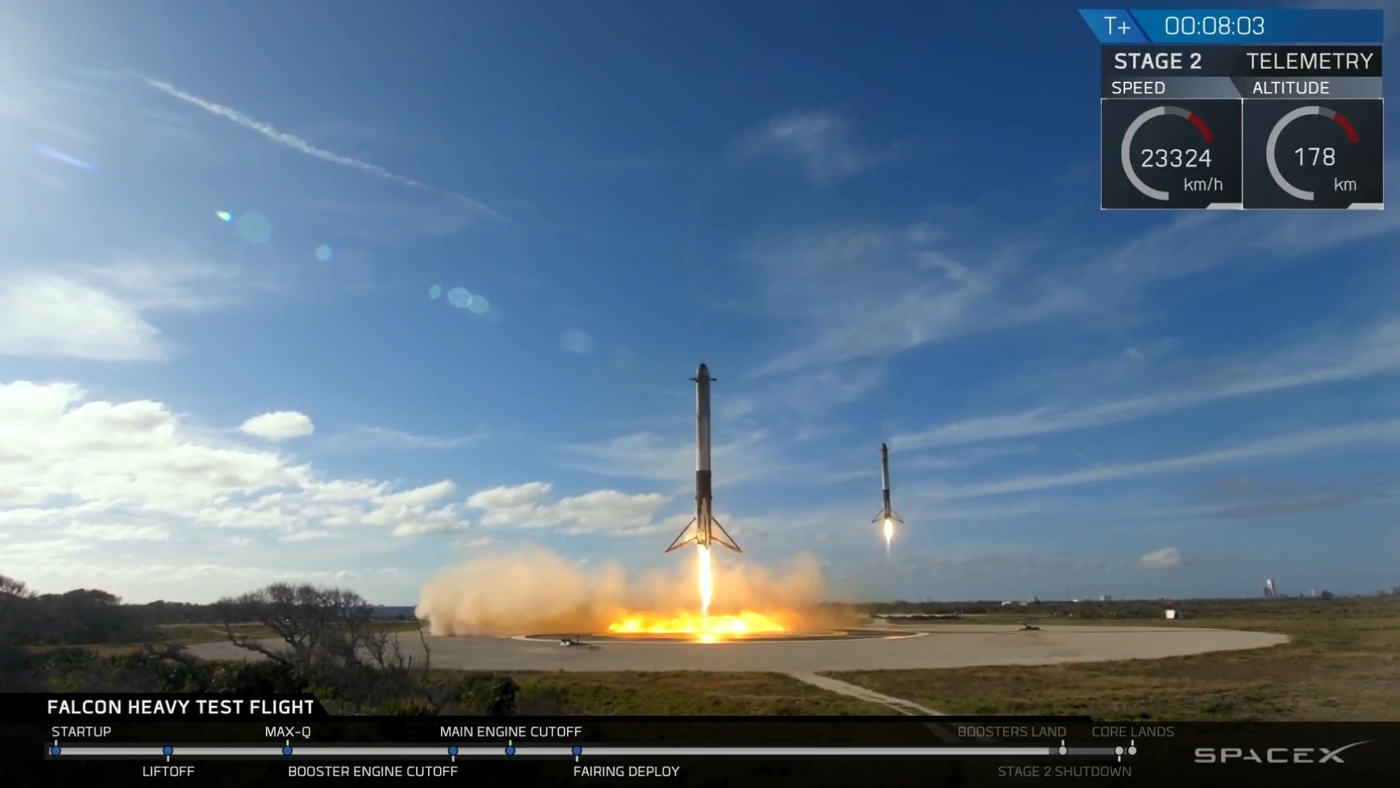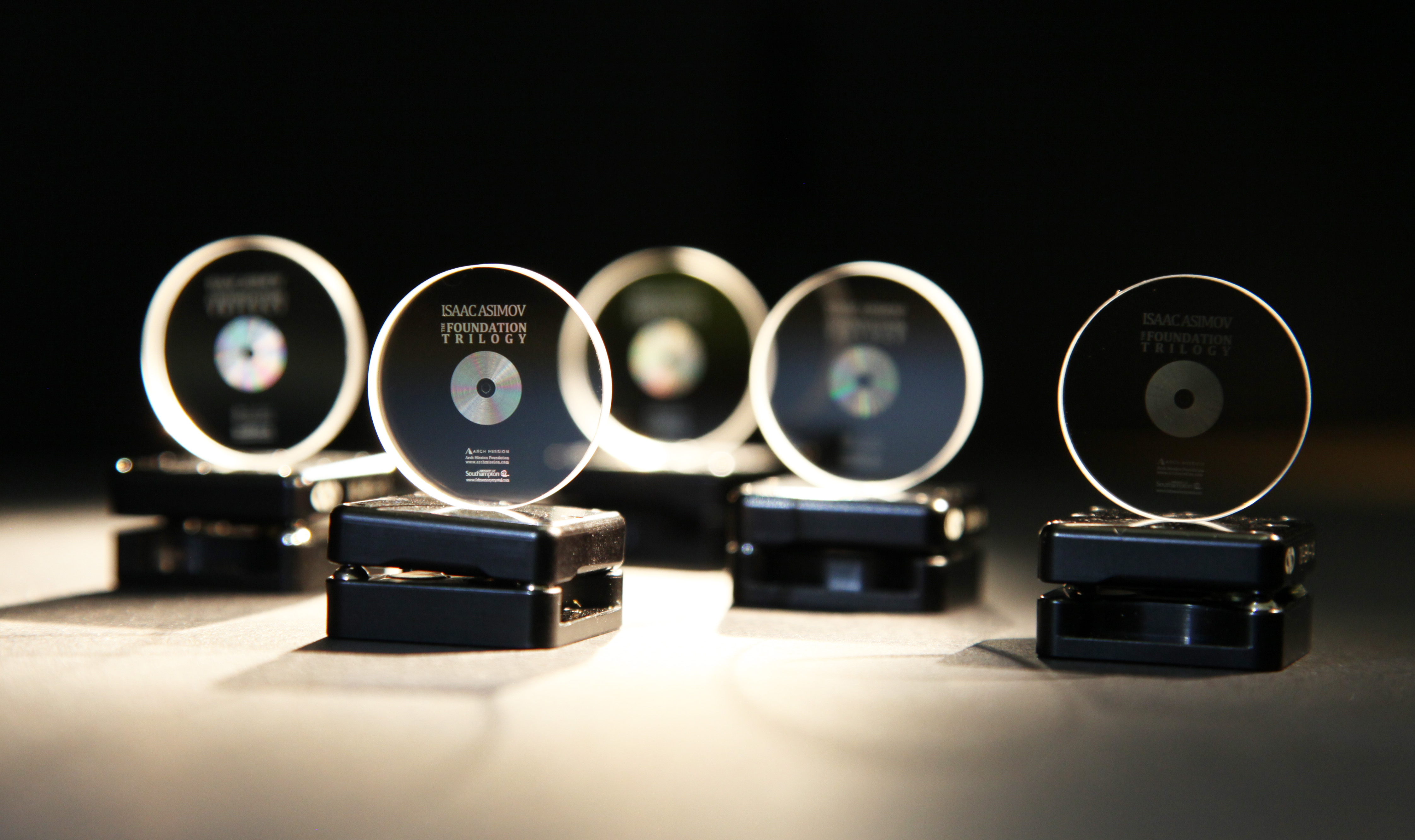The Most Interesting Thing Shot into Space This Week Wasn't a Tesla

There was a second payload on board the SpaceX Falcon Heavy that launched Tuesday (Feb. 6), and (unlike the Tesla Roadster) it's built to last 14 billion years.
SpaceX confirmed during its pre-launch livestream that the gadget, called an Arch, is tucked away somewhere inside the red Tesla Roadster now floating through space. It's a simple-looking object: a clear, thick disk of quartz crystal, about an inch across, with lettering across its face. It could almost be a small business award — best car dealership maybe, or top pizza restaurant — except for the data etched microscopically into its body with powerful, high-frequency lasers.
And that data, or at least the future suggested by that data, is what earned the Arch a ride aboard the Roadster. [Interstellar Space Travel: 7 Futuristic Spacecraft To Explore the Cosmos]
Pronounced "ark" as in "archive," it's part of a very Silicon Valley plan to — as technology investor, self-described futurist and Arch Mission Foundation co-founder Nova Spivack explained it to Live Science — create "a self-replicating, meta-level process to perpetuate human civilization."
The Foundation picked the quartz discs for this task because they can store a lot of information very compactly, without degrading much at all over long time spans. Each laser-inscribed point on the disc is just 200 nanometers wide (a bit bigger than a single HIV virus), but can encode six bits of information, Spivack said. And as long as the quartz isn't shattered or blasted with intense waves of radiation, those points should be legible to anyone with the technology to view them — even millions (or perhaps billions) of years in the future.
In a phone interview, Spivack explained that the etched quartz is part of a grand plan to seed the solar system with super-durable data-storage devices containing a vast cultural archive of human civilization.
The outside of the disks will have visible symbols on them, Spivack said, "symbols that say, 'Look, this is interesting.'"
Sign up for the Live Science daily newsletter now
Get the world’s most fascinating discoveries delivered straight to your inbox.
Then, future discs will have tiny images etched into them "like microfilm," he said, big enough to be visible with a good microscope. A future observer who discovers those symbols, the Foundation hopes, will take the time to decode the tiny dots, which will contain huge archives of information.

Why do this?
"If you look at the history of civilizations, human civilizations do a very good job of wiping themselves out," Spivack said.
And if that happened today, much of the modern cultural record — stored on degradable magnetic disks and drives and tape — would disappear within a century.
The Arch project's stated goal is to act as a kind of insurance against civilizational catastrophe. Create a durable, redundant record, leave it where future human (or alien) civilizations might find it, and our culture's collective knowledge will never die out.
It's a striking idea, at once utopian, space-age and completely fatalistic — appealing enough to a certain kind of imagination that, according to Spivack, Elon Musk agreed to carry the first Arch into space after hearing about it in a casual Twitter exchange.
Spivack insisted that he's not trying to become the author or curator of this distributed monument to modern society.
"The idea here is to send not just one or two or 10 one-off Archs, but to send millions — maybe billions — of them all across the solar system into all kinds of locations," he said.
The foundation wants to build a lunar Arch library, as well as a Mars library, among many others, and to expand beyond quartz storage into other kinds of long-term data records, including DNA.
Still, for the moment at least, Arch technology remains prohibitively expensive. And in that context Spivack reluctantly acknowledges that the foundation will have to play gatekeeper.
"The Wikimedia Foundation, Wikipedia, Project Gutenberg (e-books), human genomes and other large open-data sets are the priority," he said.
Later, he hopes to offer small chunks of the record to "donors" — people who pay, he estimated, $20 to $100 in return for the right to place some fragment of data into deep posterity. Those funds, he said, will go into an endowment, which he hopes will fund the foundation long term. Eventually, he said, if the endowment grows big enough, the foundation will give archival rights away for free.
Rather than pick and choose what ideas get preserved at that point, he said, the foundation hopes distributing the power of long-term preservation widely enough will create a truly representative portrait of human society that will live on into deep time.
"We're not going to make difficult censorship decisions because, you know, the internet is open and so is the Arch," he said. "We'll include everything, including the bad stuff, because the bad stuff is also important."
So, what's the point of all this effort? Why go through the trouble to write something down for a far-flung future audience that may never arrive — or, Spivack suggested, might be a silica-eating alien race that consumes the Arch disks as food? [Greetings, Earthlings! 8 Ways Aliens Could Contact Us]
Well, it turns out that building the Arch could be pretty lucrative.
"Some of the things that are being developed certainly have commercial potential," Spivack said.
Right now, the best way to send large amounts of information between Earth and space is via radio signals. But there are some hard bandwith limits on radio, thanks to the speed of light and other issues. Even the internet connection on the multi-billion-dollar ISS in low-Earth orbit is only about as fast as a typical home router. That's fine for the data needs of a small crew, but imagine trying to squeeze all the data needs of a Mars city through that connection, with additional delays due to distance and lightspeed.
If/when humans move into space, Spivack thinks dense, lightweight data-storage devices could become more valuable as ways of transporting, say, the contents of the internet between Earth and Mars. And tech like the quartz disks, which he said could one day hold hundreds of terabytes of information, would be perfect for that task.
Already, he said, there are plans to spin off patents from research groups involved in the Arch project into side companies — companies whose intellectual property rights will in turn fund the foundation.
For the moment though, Spivack said he's focused on getting as much data from "the humanities" up into space as possible. (The foundation, he said, assumes that any civilization that could parse the microscopic data-dots on the disks already understands our sciences.)
And as long as the foundation is playing its reluctant (according to Spivack, at least) curator role, they're acting just like you might expect from a group of Silicon Valley techno-futurists: The first Arch disks produced so far, including the one riding through space on that Tesla Roadster, contain Isaac Asimov's Foundation Trilogy.
Originally published on Live Science.











